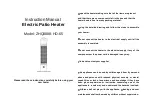
10
Combustion Air Supply
Provide adequate air for combustion and ventilation. An insufficient supply of air will
cause recirculation of combustion products resulting in air contamination that may be
hazardous to life. Such a condition often will result in a yellow, luminous burner flame,
causing carboning or sooting of the combustion chamber, burners and flue tubes with
possible damage to the water heater.
When an exhaust fan is installed in the same room with a heater, sufficient openings
for air must be provided in the walls. Undersized openings will cause air to be drawn
into the room through the chimney, causing recirculation of combustion products.
Unconfined Spaces
In unconfined spaces in buildings, infiltration may be adequate to provide air for
combustion, ventilation, and dilution of flue gases. However, in buildings of tight
construction (heavily insulated, weather stripping, caulked, vapor barrier, etc.)
additional air may need to be provided using the methods described below.
Confined Spaces
Confined spaces are spaces defined as having less than 50 ft
3
/1,000 BTU/hr
(4.8
m
3
/kW)
of input.
All Air from Inside the Building:
The confined space must be provided with two
permanent openings communicating directly with an additional room(s) of sufficient
volume, so that the combined volume of all spaces meets the criteria for an unconfined
space. The total input of all gas utilization equipment installed in the combined space
must be considered in making this determination. Each opening must have a minimum
free area of 1 in
2
/1000 BTU/hr
(2200 mm
2
/kW)
of the total input rating of all gas
utilization equipment in the confined space, but not less than 100 in
2
(0.06 m
2
)
. One
opening must be within 12 in
(31 cm)
of the top and one within 12 in
(31 cm)
of the
bottom of the enclosure.
WARNING
Liquefied petroleum gases/propane gas are heavier than air and will remain at
floor level if there is a leak. Basements, crawl spaces, closets and areas below
ground level will serve as pockets for accumulation of leaking gas. Before
lighting, smell all around the appliance area for gas. Be sure to smell next to
the floor.
IF YOU SMELL GAS:
•
DO NOT
try to light any appliance.
•
DO NOT
touch any electric switch;
DO NOT
use any telephone in your
building.
•
Immediately call your gas supplier from a neighbor’s telephone. Follow the
gas supplier’s instructions.
•
If you cannot reach your gas supplier, call the fire department.
DO NOT OPERATE APPLIANCE UNTIL LEAKAGE IS CORRECTED!
IMPORTANT
The flow of combustion and ventilating air
must
NOT
be obstructed.
DO NOT
block or in any way restrict jacket air inlet slots located at the bottom front of the
water heater.
Summary of Contents for FVIR Defender Safety System RG240T6N394264475
Page 16: ...16 Lighting Shutdown Instructions White Rodgers Mechanical Gas Control ...
Page 17: ...17 Lighting Shutdown White Rodgers Electronic Gas Control ...
Page 18: ...18 Lighting Shutdown Honeywell Gas Control ...
Page 29: ...29 INSTALLATION FOR POTABLE WATER Figure 11 ...
Page 32: ...32 NOTES ...











































